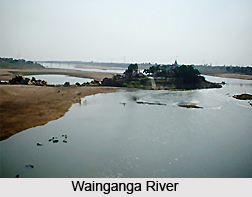 Geography of Gadchiroli district has a largely undulating topography except a narrow strip along the Godavari River and the Pranhita River. The major physiographic features of the district are Sirkonda, Bhamragad, Aheri and Dandkaranya hill ranges with high to moderate relief. The lowland of the district shows rolling topography with isolated hillocks. The eastern part of district ie Dhanora, Etapalli, Aheri and Sironcha talukas form a somewhat higher part of the district and are covered by thick forests. Hills are located in the area of Bhamaragad, Tipagad, Palasgad and Surjagad in the district. Gadchiroli district experiences extreme variations in temperature with very hot summers and very cold winters and an average relative humidity of 62 percent. The district receives rainfall from the South-Western winds, mainly in the months of June, July, August and September. July and August are the months during which the maximum rainfall as well as maximum continuous rainfall occurs.
Geography of Gadchiroli district has a largely undulating topography except a narrow strip along the Godavari River and the Pranhita River. The major physiographic features of the district are Sirkonda, Bhamragad, Aheri and Dandkaranya hill ranges with high to moderate relief. The lowland of the district shows rolling topography with isolated hillocks. The eastern part of district ie Dhanora, Etapalli, Aheri and Sironcha talukas form a somewhat higher part of the district and are covered by thick forests. Hills are located in the area of Bhamaragad, Tipagad, Palasgad and Surjagad in the district. Gadchiroli district experiences extreme variations in temperature with very hot summers and very cold winters and an average relative humidity of 62 percent. The district receives rainfall from the South-Western winds, mainly in the months of June, July, August and September. July and August are the months during which the maximum rainfall as well as maximum continuous rainfall occurs.
The entire Gadchiroli district is included in the drainage basin of the Godavari River. At the south western boundary of the district, near Sironcha, Godavari enters the district and flows eastwards for about 50 Kms along the southern boundary of the district. After its confluence with the Indravati River, at the south-eastern corner, the Godavari turns south into Andhra Pradesh. The western boundary runs for a distance of 225 Kms and is formed by the flow of the Wainganga River which divides Chandrapur district and Gadchiroli district. Khobragadi, Kathani and Mirgadola rivers are the major tributaries. The Pranhita River, formed by the confluence of the Wainganga and Wardha river, forms the south-western boundary for 190 Kms till its confluence with the Godavari. Dina River is the main tributary. The Indravati River enters Maharashtra near the Kowande village of Bhamragad Tehsil in the district and forms the south-eastern boundary for a distance of 120 Km before joining the Godavari. Parlkota (Nimbra), Pamulgautam (Kotari) and Bandia are the major tributaries. Apart from these, the major rivers flowing through the district are the Gandhavi, Pal welochanna, Siwani, Por and the Darshani.
The predominant soil cover in the district is clay, clay-gravel, sandy loam, deep black soil, reddish and yellowish brown soils on hill slopes, brown and gray soils of plains and laterite and lateritic soil. Out of the total geographical area of 14412.0 Sq.Kms, 11694.0 Sq.Kms of the land is included in the reserve or protected forest category. Out of the remaining area, only 1960.0 Sq. Kms of the land is under cultivation and constitutes only 13.14 percent of the total land of the district. Iron ore, base metals, barrettes, limestone, corundum, talc are some of the important economic minerals occurring in the district. The district can be divided into six geomorphic units of structural, denudational and fluvial origin.
Structural Origin: Structural Hill/ Ridges-Lithologically these consist of metamorphic rocks of Archaean and Proterozoic age.
Denudational Origin: Denudational Hills, Pediments / Pediplains-Denudational hills are low relief hills mostly covered with vegetation. While Pediments are concave surfaces developed at Junction of hills with the plains and exhibit undulating topography and are dissected.
Fluvial Origin: Older and Younger Alluvial Plains
The Wainganga and Godavari have developed extensive alluvial deposits along their courses. The older alluvial plain is a flat surface of large aerial extent gently sloping towards these rivers and representing an earlier cycle of deposition. The unconsolidated material in this unit consists of sand silt and kankar with thickness as high as 30 m. The younger alluvial unit represents a later cycle of deposition.






